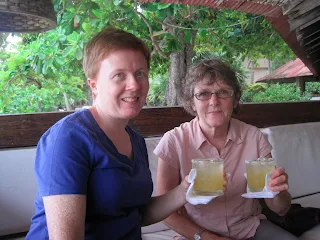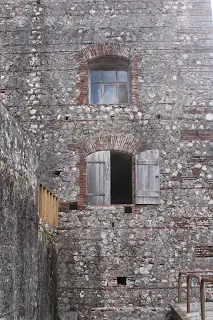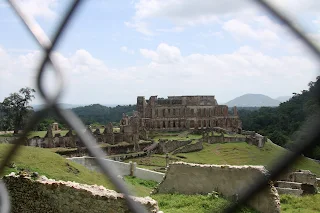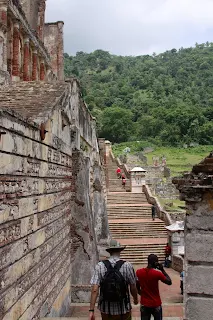 |
| Haiti a du pétrole, de l'or et de l'iridium |
Au cours d’une émission de radio en Floride, un ami me rappela à brule-pourpoint que les Occidentaux exterminèrent les premiers habitants d’Haïti, les Indiens dits Indiens par Christophe Colomb, pour pouvoir mieux voler leurs richesses minérales, particulièrement de l’or. Ensuite, la publication de l’article de l’ « Associated Press » sur la découverte de l’or en Haïti, gisement estimé à plus de 20 milliards de dollars, nous prend à la gorge. Une révélation pareille donne à la fois des sueurs froides aux patriotes haïtiens et du grincement de dents aux exploiteurs occidentaux. Les richesses minérales ont été toujours à la base de beaucoup de génocides de l’histoire. Ainsi, l’extermination des Arawaks/Taino, les natifs d’Haïti. D’après des sources espagnoles de l’époque, ils étaient des millions en Hispaniola. En 1507, un recensement fit état de 60.000 Indiens restant, après 24 ans, soit en 1531, ils étaient réduits à une poignée de 600. Aujourd’hui, il n’en reste que des vestiges archéologiques. Un tel constat révèle la cruauté impitoyable des conquistadores. Ce fut la première expérience barbare liée directement à l’exploitation de l’or à laquelle les habitants d’Haïti firent face, c’était au 16e siècle. L’or s’achemine vers L’Europe et les natifs, vers le néant.
 Haïti n’a pas beaucoup de chances quand il y a « ruée vers l’or ». D’après l’historien J.A. Rodgers, Toussaint Louverture, dans sa quête de libération pour ses frères en Afrique, rêvait d’y retourner. Une fois là-bas, il entendait empêcher le commerce des noirs qui se pratiquait à grande échelle. Ainsi, il confia beaucoup de franc-or à Mr Stephen Girard, un capitaine de bateau américain d’origine française, qui mouillait fréquemment dans la rade de Port-au-Prince, un ami à lui. L’objectif de cette entreprise, toujours selon Mr Rodgers, fut d’accumuler une forte quantité d’or pour pouvoir matérialiser financièrement son projet contre la traite négrière. La valeur de cet or fut estimée à plus de 6 millions de dollars américains. Tout ceci est reporté dans le livre : « 100 Amazing facts About The Negro ». Après l’acte vil de Napoléon qui piégea Toussaint Louverture et l’envoya en France, Stephen Girard décida de conserver l’or pour lui-même au lieu de le remettre aux enfants et à la femme de celui-ci après son internement à Fort-de-Joux, en France. A rappeler ici, que la femme de Toussaint fut humiliée, torturée atrocement par les bourreaux de Napoléon à la recherche de l’or caché du mari.
Haïti n’a pas beaucoup de chances quand il y a « ruée vers l’or ». D’après l’historien J.A. Rodgers, Toussaint Louverture, dans sa quête de libération pour ses frères en Afrique, rêvait d’y retourner. Une fois là-bas, il entendait empêcher le commerce des noirs qui se pratiquait à grande échelle. Ainsi, il confia beaucoup de franc-or à Mr Stephen Girard, un capitaine de bateau américain d’origine française, qui mouillait fréquemment dans la rade de Port-au-Prince, un ami à lui. L’objectif de cette entreprise, toujours selon Mr Rodgers, fut d’accumuler une forte quantité d’or pour pouvoir matérialiser financièrement son projet contre la traite négrière. La valeur de cet or fut estimée à plus de 6 millions de dollars américains. Tout ceci est reporté dans le livre : « 100 Amazing facts About The Negro ». Après l’acte vil de Napoléon qui piégea Toussaint Louverture et l’envoya en France, Stephen Girard décida de conserver l’or pour lui-même au lieu de le remettre aux enfants et à la femme de celui-ci après son internement à Fort-de-Joux, en France. A rappeler ici, que la femme de Toussaint fut humiliée, torturée atrocement par les bourreaux de Napoléon à la recherche de l’or caché du mari.  |
|
|
En 1914, les Américains envahirent le pays. Ils firent un hold Up à la banque de la république d’Haïti et emportèrent la réserve d’or nationale. Ils occupèrent le pays pendant 19 ans. Aujourd’hui encore, l’or de « Tonton Nord » se trouve toujours dans les réserves stratégiques fédérales des États-Unis d’Amérique.
 |
Un explorateur se tient près du puits d'une mine datant
du XVIè siècle. Photo:Florida Museum of Natural History
|
Le Canada qui assure les explorations minérales sur le terrain en Haïti depuis 2006, à travers la compagnie EMX, affiche un certain retard sur la liste des pays détenteurs d’or. Le Canada est en 80e position avec seulement 3.4 tonnes de réserve. Donc, dans un contexte économique et financier mondial pareil, ce pays a besoin de beaucoup d’or pour renflouer sa réserve. D’ailleurs, il n’est pas le seul, d’autres géants économiques emboîtent le pas aussi. Les États-Unis qui contrôlent la plus grande réserve d’or de la planète, en première position avec 8133,5 tonnes, s’activent beaucoup aussi sur le marché de l’or. A noter que, les États-Unis prirent des 1933 un arrêté l’« executive order 1602 » mettant hors la loi tout citoyen susceptible de posséder de l’or. Seul le gouvernement fédéral fut autorisé à en garder. Pour préserver plus de 12 milliards de dollars en or, Franklyn D. Roosevelt a ordonné la construction à Fort Knox, Kentucky, du coffre-fort le plus sécurisé au monde jusqu’à nos jours. Le « United States Bullion Depository », il est placé en plein cœur de l’un des plus grands camps militaires du pays. Il est surveillé jour et nuit par plus de 30.000 soldats appartenant a : « l’aéroport militaire de Godman», « 16th régiment de cavalerie », « Bataillon du génie », l’« Equipe de combat de la 3eme brigade », la « 1ere division d’infanterie »…sans oublier : « United States Mint Police », des systèmes d’alarme, des caméras de vidéo, des hélicoptères apaches, des véhicules blindés de transport de troupes …On parle même de minage à intervalle de certains tronçons conduisant au bâtiment. Donc, l’or, contrairement à la croyance populaire a une importance supérieure à l’admiration illusoire que fait miroiter un bracelet, une bague ou une chaine…
 |
A Lakwe, dans le nord d'Haïti, l'orpailleuse extrait des
sacs de glaise dans un puits, elle espère trouver de l'or
|
Ils sont de retour !
Ils sont du même sang !
Ils viennent de l’Europe !
Le Canada et les États-Unis remplacent respectivement l’Espagne et l’Angleterre; c’est-à-dire, la même fresque épidermique de Caucasiens aux yeux bleus/verts qui se disent issus d’une race supérieure. Perpétuellement, avec la même rapacité, c’est-à-dire la même soif ardente de voler et de tuer pour s’accaparer de tout. Toujours l’identique stratégie de diviser pour mieux régner : tribaliser la nation en parachutant un valet au pouvoir et morceler tout un continent par zones d’intérêts. Le trio infernal, États-Unis/France/Canada, à l’instar de celui du 15e siècle-le trio France/Angleterre/Espagne, se prépare pour le deuxième grand pillage d’Haïti, voir l’extermination de ceux qui résistent.
A l’heure de l’alerte du grand drame humain se joue la tragédie de la « chronique d’une mort annoncée ». Beaucoup de penseurs estiment qu’il faut exorciser les peuples victimes de l’histoire. En leur enlevant leur innocence. Il faut les réveiller de ce profond sommeil injecté par l’ordre mondial sur mesure. C’est l’heure de grands réquisitoires et de véhémentes dénonciations. Sinon, c’est la défaite qui nous consumera. Cette fois, il faut anticiper l’histoire pour l’imposer a notre humanité. Elle est trop cruelle envers nous, dirait l’auteur de « Les Veines Ouvertes de L’Amérique ». Il faut arrêter les tours et contours meurtriers de l’histoire. Cette dualité de bourreaux et victimes, agresseurs et proies touche à sa fin. Que l’or d’Haïti soit la sépulture des exterminateurs des Indiens.
Il y a six siècles de cela, les occidentaux firent disparaitre toute une classe d’hommes et de femmes. Il n’y avait pas eu de transition entre les Arawak/Tainos, les premiers habitants d’Haïti, et les noirs arrachés de leurs royaumes africains. Cela signifie que l’Ile d’Haïti avait vécu le premier nettoyage ethnique de l’hémisphère occidental.
 |
Christophe Colomb et ses hommes ont souvent échangé
des babioles et des cloches contre des pépites d'or.
|
En écoutant le documentaire audio de « Ayiti Je Kale », on a l’impression que le peuple, appuyé par ses intellectuels progressistes, se prépare déjà à la résistance nationale. Le gouvernement actuel, par son manque de légitimité, est appelé a ne pas négocier aucun contrat avec « EURASIAN », « NEWMONT » etc, les principaux pillards internationaux des mines. D’ailleurs, Dieuseul Anglade, un ancien directeur général du bureau des mines, a déjà exhorté les autorités actuelles dans ce sens, et je cite : « Je leur ai dit de laisser les minerais sous terre les générations futures pourront les exploiter ». La nation d’Haïti est condamnée à ne pas manquer cet autre rendez-vous. Celui-là est fondamental parce qu’il s’agit des ressources naturelles nationales du pays.
Hugo Chavez, en commentant sa dernière visite en Haïti devant le parlement vénézuélien tout de suite après le tremblement de terre du 12 janvier 2010, a avoué avoir vu dans le pays des « Portes de l’enfer habitées par des anges noirs ». Donc, le moment est venu de briser ses portes de l’enfer en utilisant nos propres ressources et combattre le grand capital financier international toujours prêt à piller. Sans pourtant ignorer la complexité de la situation globale du pays.
 |
A Lakwe dans le nord d'Haïti, cette orpailleuse espère
trouver de l'or dans cette eau boueuse.
|
D’abord, en considérant le caractère valet de l’exécutif et puéril du législatif, il est impérieux qu’ils n’engagent pas le pays dans des accords avec des compagnies étrangères pour l’extraction de l’or. Ce déficit de confiance doit être résolu avant de penser à l’utilisation des mines nationales. Pour cela, il faut avoir des hommes politiques patriotes aux affaires, pour éviter que soit gaspillée cette chance ultime. D’où l’importance des élections à venir.
Par :Joël Léon
La source originale de cet article est Mondialisation.ca
Copyright © Joël Léon, Mondialisation.ca, 2012
Illustrations: Haiti Connexion Culture
Illustrations: Haiti Connexion Culture
















































































